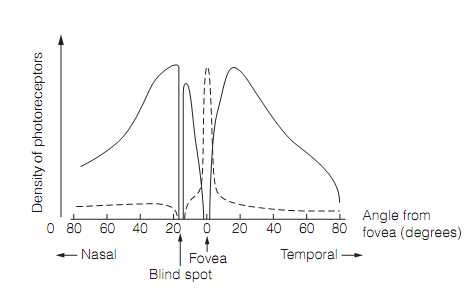Rod cells
The Rod cells are 20-fold more numerous than cones and are spread across the whole retina except for the fovea and the optic disc which is as shown in figure. They are 1000 times more sensitive to light than cone cells and is used for the scotopic (i.e., dim light) vision. In fact, the rod cells become unresponsive in daylight. The high sensitivity of rod cells is partly as they integrate responses to incoming photons over a long period (~100 ms).The drawback of this is that rods are not capable to discern flickering light if the flicker rate is faster than about 12 Hz. The Rod cell sensitivity is also due to their vast amplification of the effect of incoming photons. The Scotopic vision has low acuity because of two reasons. At first, the image created on the peripheral retina is distorted. Secondly, most of the rods converge onto a single bipolar cell. However this maximizes the chance of a rod bipolar cell responding to a dim light signal, as it can capture the light signals from a large region of retina, by the same token of information about the localization which is less accurate.

Figure: Distribution of cone (- - - -) and rod (––––) photoreceptors in the human retina.